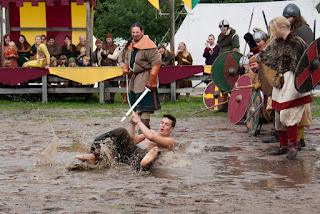 Today let’s take a journey from the ancient
Olympics, stop by Denmark for some Viking practices, sojourn with the Inuit and
Chippewa cultures, and steal an idea or two from the boxing heavyweight great
Joe “The Brown Bomber” Louis.
Today let’s take a journey from the ancient
Olympics, stop by Denmark for some Viking practices, sojourn with the Inuit and
Chippewa cultures, and steal an idea or two from the boxing heavyweight great
Joe “The Brown Bomber” Louis.
First, let’s define our terms.
By movement under load training I refer not to
weight lifting but the conducting of your sport/training with additional weight
or added resistance hampering your standard movement in the aid of increasing
performance once the limiter is removed.
Let’s start with the ancient Hellenes.
In the original incarnations of the Olympic
Games, the jumping events, standing broad jump, running jump, clearing obstacle
et cetera were conducted with devices called halteres. Halteres were bits of stone or metal loosely shaped like
a modern dumbbell.
The athlete would grasp the two ends of the haltere and use a swinging momentum of
the arms to “assist” the jump without ever releasing the device. It was thought
that halteres would increase strength
and difficulty.
It does--In my own experiments with mock haltere [grasping a dumbbell] my
swinging jump coordination leaves much to be desired, and the landing g-forces
left me leery of attempting maximal efforts.
However, no less a personage than Aristotle in
his On the Movement of Animals states:
“A pentathlete using halteres jumps farther
than one without them.”
Gradually these devices faded from being used
in the games but were still used in the training of the jumpist. [An archaic word
I have grown fond of.]
Next cultural stop—the fjords of Scandinavia.
There are numerous refences in the sagas to
Vikings training in knee and waist high water. They would run, jump, and engage
in mock combat in this depth to both garner strength and to train in conditions
they were likely to encounter in storming beaches.
There are numerous references in the anthropological
record of Northern tribes, the Inuit and Aleut among them, competing in running
and sprinting in various depths of snow. Here the snow acts in the same resisting
manner as does the melted form in the Viking counterpart of the training.
American Indian tribes have a deep and resonant
history of running. Running for war training, running for escape training, and
running for ritualized purposes. Many tribes had their own form of adding resistance
to the runs, ideas ranging from partner carries, stone hauls, creek running
[the Viking idea rears its head again,] running in deep sand along dunes, hill
and mountain running, but let us look to the Chippewa tribe for a specific
device to add resistance.
 As part of a tradition linked to the deity
Part-Sky Woman, runners would attach decorative weights filled with lead shot
to the bare-feet. Many miles were run with these ankle-weights, but they were
shed for tribal competition or warfare.
As part of a tradition linked to the deity
Part-Sky Woman, runners would attach decorative weights filled with lead shot
to the bare-feet. Many miles were run with these ankle-weights, but they were
shed for tribal competition or warfare.
Let’s bring it to the 20th century.
Movement underload training is still used, most
extensively by the military in the form of rucking, which has gradually made its
way to aspects of civilian athlete training.
In boxing and wrestling training there is a
long-tradition of wearing ankle-weights ala the Chippewa to add resistance to distance
runs.
But let’s look to the great Joe Louis for two
ways, one standard, and one less so, that he used to assist his long tenure as
heavyweight champion of the world.
The Brown Bomber did his Rock-Runs [we will
play with Rock-Runs another day] in a pair of heavy boots. His trainers, Jack Blackburn
and Mannie Seamon, made it a point to select heavy boots for roadwork. The heavier
the better.
 Another less expected practice to build sport
specific resistance—a thicker than average padding beneath the canvas of Louis’
training ring.
Another less expected practice to build sport
specific resistance—a thicker than average padding beneath the canvas of Louis’
training ring.
Seamon regularly added ¾” of padding to the standard
padding depth so that Louis was working against resistance in both movement and
power throughout his training. Seamon felt that when it came to fight night it
gave the champ added snap to his punches and made his movement lighter more
akin to a middleweight.
I can testify to a bit of that. I use a double
layer of reselite wrestling mats for training, and when stepping onto a single
layer it feels absurdly fast.
There are many more examples from history, cultures,
and individual athletes of movement under load training, but the offered instances
should give us a healthy respect for the practice and perhaps cause us to consider
adding a few of these ideas to give our own training, giving it a bit of historical
heft.

Comments
Post a Comment